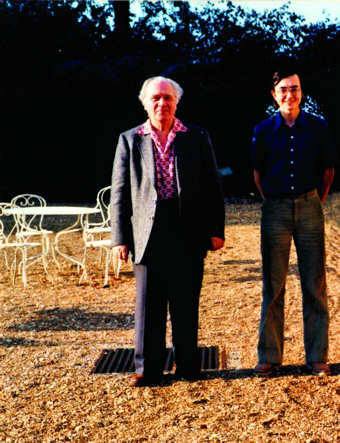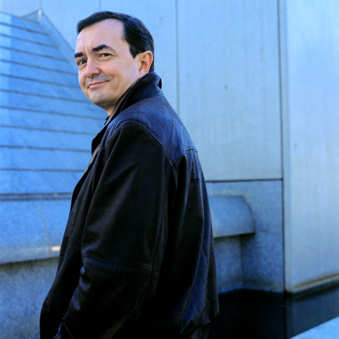Other Links
Editorial Board
- Editor - Bill Kenny
- London Editor-Melanie Eskenazi
- Founder - Len Mullenger
Google Site Search
SEEN
AND HEARD FESTIVAL PREVIEW
The Music of
Olivier Messiaen, From the Canyons to the Stars:
A report from Anne Ozorio,
South Bank Centre, London, 1 February – 10 December 2008 (AO)
“This is the most comprehensive Messiaen retrospective ever” said
Gillian Moore, Head of contemporary culture at the South Bank.
She’s right. This is a festival of international significance,
which will be remembered as a landmark for many years to come.
Olivier Messiaen’s influence cannot be underestimated. He bridges
tradition and innovation. Indeed, Messiaen is a key to
appreciating most European music since the mid 20th
century.
Monumental works like Turangalîla-symphonie, and La
Transfiguration de Notre Seigneur Jésus-Christ aren’t heard
often enough live because they require such forces, but they are
so spectacular that they can’t be missed. Aimard himself is
playing another tour de force, Vingt Regards sur
L’Enfant-Jésus. It will be an experience no recording can
quite match. A newly-published piece for piano and violin,
Fantaisie, is being premiered. The famous Quartet for the
End of Time gets two performances. Only the opera, St
Francis of Assisi, is missing. Sometimes, it’s just not
possible to overcome “the charm of impossibility”, a phrase
Messiaen himself created. It’s good that we already have so much.

Olivier Messiaen (left) and Pierre-Laurent Aimard
The Festival Director is Pierre-Laurent Aimard. “We met”, he says
modestly, “because my piano teacher was Mme Loriod”. He was twelve
years old. Mme Loriod was Messiaen’s muse, collaborator and
partner for nearly 50 years. Indeed, it is because Aimard was so
close to the composer that this Festival is unique. On 2nd
February, Aimard and George Benjamin, who met Messiaen aged 17,
discussed their personal memories of Messiaen’s personality. He
was so charismatic that they learned a lot more from him than
“just” music. He was an unworldly figure, who could sit “serenely
calm” for hours on end, “like a rock”, but was always listening
acutely. What might seem to others as his naivety springs from his
innate simplicity and purity of spirit.
He was also systematic and objective. He had 12 pairs of
spectacles lined up, each for a specific purpose. This translates
into his music, where every little detail is there for a reason
and must be clearly defined. Messiaen often used the image of a
stained glass window to describe his work. A stained glass window
is magnificent because light shines through it, making it a blaze
of myriad colour. Yet it is made of numerous individual fragments
of glass, each unique, depending on their hue, density of glass,
angle of placement etc. Moreover, as light changes, the colours
reflect and refract differently : nothing remains unchanged even
though the glass itself doesn’t move. It is a wonderful metaphor
for what happens in Messiaen’s music.
Aimard also knows everyone connected with the composer. This is
about as authoritative a festival as there is ever likely to be.
Mme Loriod may not be playing, but Aimard, Uchida, Latry and
Salonen will be there, and Pierre Boulez, perhaps one of
Messiaen’s closest associates, will be conducting the keynote
concert on the very day of the composer’s centenary, 10th
December.

Pierre-Laurent Aimard - Picture © Guy Vivien
Another special feature of this Festival is that it places
Messiaen’s music in context. He was a highly spiritual person,
for whom music was an expression of profound faith. The Festival
actually started with a conference on music and spirituality.
Although Christian symbolism infuses most of his work, his is a
spirituality which transcends specifics, seeking a higher
communion with the very essence of belief. Stockhausen, Boulez,
Pärt, Grisey, Takemitsu and others may not write “Christian” music
as such, but their work is enhanced by this powerful sensibility.
Messiaen’s interest in birdsong, nature and non-western cultures
stems from the idea that God is in all things. Similarly, his
interest in synaesthesia comes from the idea that sound and sight
connect intuitively. On 15th February, there’s a forum
on interpreting visual images in performance.
Messiaen himself played the organ nearly every day at the Trinité,
so his music for organ will feature prominently later in this
Festival. The South Bank will include “North Bank” venues such St
Paul’s Cathedral. The great organ at Westminster Abbey will be
used for a performances of Apparition de l’église éternelle
and La Nativité du Seigneur by Olivier Latry, who will also
be giving a masterclass. Organists don’t often get so many
chances to gorge themselves on feasts like this.
Three days a week, Messiaen devoted to teaching, because he
believed so strongly in the value of nurturing talent. Many
events are taking place at the Royal Academy of Music, inspiring a
new generation. This is particularly good programming, too,
because it means many smaller works can be included. Also being
performed are works by those whom Messiaen learned from, such as
Dukas, and those he taught. Gerard Grisey’s superb Les Espaces
acoustiques receives its long overdue UK premiere on 14th
October. Messiaen taught the teenage Boulez, and used his music
to teach others. Messiaen’s Et exspecto resurrectionem
mortuorum is being performed with Boulez’s Rituel in
Memoriam Bruno Maderna, a composer whom they both knew.
A very good example of Aimard’s enlightened approach to this
Festival was the Study Day on the Quatuor pour le fin du Temps,
held on 3 February. Aimard gave a cogent analysis of the work,
playing “Messiaen chords” on the piano to demonstrate. The basic
cells shift imperceptibly, “like the turning of a kaleidoscope”.
Values change, rhythms change and sometimes there are extra notes.
“It is a game of permutation, a game of time”, he says. This is
nothing like Bach, or the kind of conventional polyphony we’re
used to. Messiaen’s polyphony exists as if in suspension.
Layers don’t depend on relationships to interact, but flow of
their own volition. This is “the music of immateriality”,
defying concepts of time and movement, a radical approach to
fundamental assumptions on the nature of music. He had Paul
Watkins and Marianne Thorsen play the violin and cello first as
Messiaen suggested, then in conventional mode. Watkins also
demonstrated how the notorious cello passage is played, so close
to losing the legato. Time and sound are stretched to their
limits.
Cameras were in the hall to film the proceedings. What will
eventuate will be interesting. In another time warp Messiaen
would have enjoyed, there was a first screening of a new,
unreleased film about the Quartet for the End of Time.
Titled The Charm of Impossibility, it describes how the
piece came to be written. It was filmed in Görlitz in Silesia, on
the site of the former POW camp. At first it seems as if the huts
in the camp are being shown. Then the camera moves. What’s
being filmed is just a scale model. A former POW walks around the
trees where the camp used to be. All traces are gone, and he says
“I’ve lost my bearings”. That in itself is a good metaphor for
what the music is trying to express.
There’s a reconstruction of what that first performance might have
sounded like, where the prisoners played on broken, tuneless
instruments. The film makers found instruments of the right
vintage, with similar defects. The cello strings were so worn they
had almost no vibration, and one of the piano keys was broken,
just like the one Messiaen used. The musicians even wore the same
kind of wooden clogs the prisoners wore. These make a cracking
sound as they move on the wooden floor. It must have been
interesting to manipulate the pedal of the piano. The film ended
with another performance with conventional instruments played in a
ruined building. When the violin holds its last long notes as the
piano fades into silence, the film merges the image of the stage
with the image of the bare stone walls. Gradually we see less and
less of the musicians, as their image merges into the abstraction
of the wall. Then all we see is the impenetrable surface of the
stone itself. Again, this expresses the granite like angularity in
the music, the strong Angel from the Book of Revelation, and the
idea of Time itself, paradoxically changing and unchanging.
The Nash Ensemble returned to play the Quartet through
uninterrupted. I couldn’t, however, shake the image of the filmed
reconstructed POW performance in its harshness and desolation.
